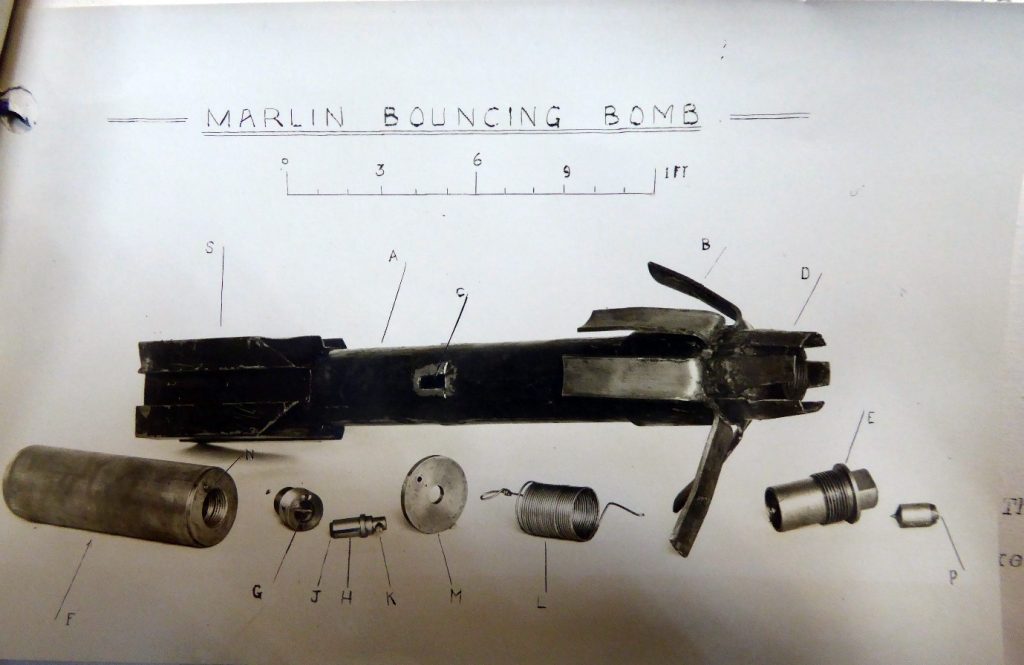
The World War 1 bouncing bombs on Orford Ness
The term “bouncing bomb” is generally associated with Barnes Wallis and Operation Chastise, the destruction of the Ruhr Valley dams. Recent research into work undertaken on Orford Ness during World War One (WW1) has revealed that three types of “bouncing bomb” were tested with varying degrees of success. Two were designed as anti-structure munitions whilst the other was an anti-personnel device. In this short article these three bombs are described with a discussion on how the WW1 “bouncing bombs” may be viewed as antecedents to modern munitions. There is also a description of a system to drop live grenades from an airframe, which appears to be one of the earliest attempts to deliver an intense and devastating materiel and morale effects in a compact area.
Why develop a bouncing bomb?
WW1 aerial bombs were fitted either with a point detonation nose fuse, which would initiate an explosion on impact, or a time delayed tail fuse initiated after impact.1 Effectiveness could be blunted or nullified if bombs buried themselves at depth in soil or mud. Many Orford Ness studies into munition effectiveness regularly reported that bombs fell into the marsh and sank to a depth such that “if they exploded a crater was not formed.”2 This reduction in effectiveness was demonstrated in a study where a 50lb bomb was buried 4 feet beneath a section of railway line and detonated. 3 A crater was formed but the tracks were barely damaged. One method that could prevent reduction in effectiveness would be if the main charge could be projected into the air before it was detonated. It was from this reasoning that the bouncing bombs were developed.
The Giding bouncing bomb
The Giding Bouncing Bomb was developed at Woolwich Arsenal and was tested in 1916 4. The bomb weighed 57 lb, of which half was the lethal payload. In operation, 0.3 seconds after impact the nose fuse set off a burning charge which propelled the explosive canister upwards where, after a further 0.25 seconds a bursting charge would detonate. There is no information on how these fuse times were set. It was expected that the bomb would burst at around 50 feet above ground level.
The bomb was not successful. On the marsh range it tended to “bury itself too deep to explode” and could not be recovered. On the shingle range one bomb detonated, but did not propel the charge above ground level. Two bombs did not detonate due to technical issues with the initiation of the burning charge. It was concluded that the bomb was no better than those in-service and should not be further developed. This was not the end of the bouncing bombs.
The Marlin (Barlow) Shrapnel Bomb
The next development was the Marlin (Barlow) Shrapnel Bomb (Figure 1) 5. Similar in shape, size and weight to the 112lb bomb, the lethal payload comprised about half the bomb. In-flight compressed air from tank (T in Figure 1) forced out a 6 foot steel hollow tube which was designed to stick in the ground on impact. This forced a striker to be driven into the tube which fired a bullet to detonate the bomb.

Figure 1: Marlin (Barlow) bomb.6
The bomb was stable in-flight and worked on shingle or marsh producing very shallow craters, indicating an enhanced aerial blast, and a shrapnel shower which penetrated ½” thick steel plate. The ballistic performance was poorer, however, than the in-service 112lb bomb as fewer fragments were produced. It was recommended that this should not be further developed as the many small moving parts would be difficult to assemble in field conditions and the whole bomb was more costly than the in-service item.
The Marlin bouncing bomb
The Marlin Bouncing Bomb (Figure 2) was an anti-personnel munition which was designed to burst at a precisely set distance above ground.7 It was less than 2 feet in length and weighed 12lbs. When dropped the inner and outer casings (B and D, Figure 2) spread open to prevent the bomb from penetrating the ground. On impact a small charge propelled the bursting charge upward which was connected to the main casing by a 6 foot coil of piano wire. Detonation was initiated when the wire was fully extended.
In tests the bomb performed well, producing a shower of shrapnel fragments and causing appreciable damage. The main criticisms were that the percentage of lethal weight of shrapnel was rather low compared to the overall weight. Further the shrapnel fragments were large and had a reduced lethality when compared to smaller faster moving fragments. The investigators were enthusiastic about the concept but recommended that the ratio of lethal to overall weight should be increased. It does appear that there was no further development and that this was the last bouncing bomb tested on the Ness.

Figure 2: The Marlin bouncing bomb 8
Dropping live grenades
Although there is no link between the bouncing bombs and dropping live grenades from an aircraft both notions sought to produce a system which did not bury itself in mud and would produce a concentrated shrapnel effect. The Lloyd-Lott dropping gear for Mills Grenades, which were the main hand grenade used by British Forces in World War 19, was an attempt to produce an intense compact area effect on ground targets. In operation individual Mills grenade were packed either in a perforated cardboard or porcelain case which prevented the striker lever from initiating an explosion in transit. Seven grenades were packed into a dropping tube, six of which were loaded onto a specially designed bombing rack which could be mechanically initiated by the pilot. On pulling a lever the tubes tipped to the perpendicular allowing the grenades to fall out and explode on impact when the casings broke.
Tests showed that the cardboard cylinders, when dropped from 500 feet would bury themselves in the marsh and not initiate an explosion. The porcelain cylinders would shatter when landing on soft ground, allowing the grenade to explode. The cylinders would, however, also shatter if dropped from 12 inches onto concrete, a particular hazard when arming the aircraft! Perhaps, surprisingly, it was not possible to make the grenade tubes explode when hit by machine gun fire. The terminal effect was, however, very impressive. When dropped from 2000 feet it was possible to cover an area 100 yards by 30 yards with grenades. When dropped from 200 feet and the aircraft travelling at 140mph in a dive the grouping was 12 yards by 5 yards. Unfortunately, the problem of munitions not firing when landing on muddy surfaces could not be completely solved and the idea of dropping grenades from aircraft was not continued as WW1 had ended.
Concluding comments
Like many ideas tested and developed on Orford Ness during WW1, such as oblique aerial photography, the bouncing bombs and dropping grenades from aircraft are largely forgotten, but they are of historical significance, because the concepts were to be very successfully reworked in later years. We must marvel at the vision and ingenuity of Gidding, Marlow and Lloyd-Lott in developing solutions to increase the effectiveness of air delivered munitions. Marlow’s use of a length of piano wire to detonate the main charge was simple, effective and an elegant solution. To date further information on the later careers of Mr Gidings, Mr Marlow or Lt. Lloyd – Lott have not come to hand.
During World War 2 (WW2) proximity fuses and the initial steps to developing tandem warheads were developed, usually to counter very different threats than those envisaged in WW1. These developments, probably unknowingly, re-invented and implemented the concepts worked through by Gidings, Marlow and Lloyd – Lott.
World War 2 saw the development by, initially the German Army, and then other nations of so-called “bounding mines”, the most notorious being the German S6 or “Bouncing Betty”. Initiated either by a trip wire or being trod on the mine would work in the same way as the Marlin Bouncing bomb. An initial charge which propelled the main charge to approximately chest height where it exploded. Such devices are still in use today.
A very early non-mechanical proximity fuse was partially developed by William Butement when he produced a simple breadboard concept demonstrator which used pulse modulated 600Mhz radio waves to detect ships at sea. 10 Butement later moved to Bawdsey Manor to work with Watson-Watt on the successful development of Range and Direction-Finding (RDF) equipment for aiming anti -aircraft and anti-shipping guns. At the outbreak of war, he worked with Curran and others at the Telecommunications Research Establishment, Malvern to develop the circuit diagrams for a miniaturised pulse – Doppler RDF proximity fuse. 11 12
References
- See, for example, Report B.23. 15 second delay tail fuze for 100 and 110lb bombs, dated 31 August 1916. The National Archive (TNA) Air 1/1199/204/5/2604.
- See, for example Report 91. The R.L. 50lb Bomb, dated 11.9.1917. TNA Air 1/1199/204/5/2604.
- Report 61a. Effect of 50lb bomb on railway track, dated 20/9/1917. TNA Air 1/1199/204/5/2604.
- Report B.24. The Giding Bouncing Bomb, dated 8/9/1916. TNA Air 1/1199/204/5/2604.
- Report B.63. Marlin (Barlow) Bouncing Bomb, dated 18/04/1917. TNA Air 1/1199/204/5/2604.
- ©Crown Copyright 1917
- Report B.66. Marlin Bouncing Bomb, dated 22/04/17. TNA Air 1/1199/204/5/2604.
- ©Crown Copyright 1917
- Report B170. Dropping Gear for Mills Grenades, dated 26 September 1918. TNA Air 1/1199/204/5/2604.
- Butement, W. A. S., and P. E. Pollard; “Coastal Defence Apparatus”, Inventions Book of the Royal Engineers Board, Jan. 1931
- Brennan, J. W. The Proximity Fuze Whose Brainchild? (September 1968). United States Naval Institute Proceedings 94 (9): 72–78, September 1968
- Brown, L; A Radar History of World War II, Inst. of Physics Publishing, 1999, p. 60
